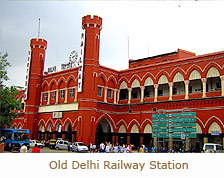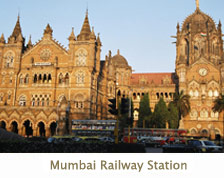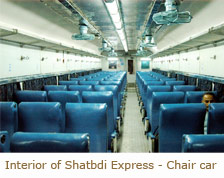Indian Railways
 Indian Railways has one of the largest and busiest rail networks in the world, transporting over 18 million passengers and more than 2 million tonnes of freight daily.It is the world's largest commercial or utility employer, with more than 1.4 million employees. The railways traverse the length and breadth of the country, covering 6,909 stations over a total route length of more than 63,327 kilometres (39,350 miles). Indian Railways operates about 9,000 passenger trains daily across twenty-eight states and one Union territory. Pondicherry, Sikkim, Arunachal Pradesh,and Meghalaya are the only states not connected by rail.
Indian Railways has one of the largest and busiest rail networks in the world, transporting over 18 million passengers and more than 2 million tonnes of freight daily.It is the world's largest commercial or utility employer, with more than 1.4 million employees. The railways traverse the length and breadth of the country, covering 6,909 stations over a total route length of more than 63,327 kilometres (39,350 miles). Indian Railways operates about 9,000 passenger trains daily across twenty-eight states and one Union territory. Pondicherry, Sikkim, Arunachal Pradesh,and Meghalaya are the only states not connected by rail.
It is often said, that the best way to see India, is at ground level on the Indian railway system, and not at 30,000 feet. In fact, no visit to India would be complete without the experience of travelling on Indian trains and negotiating busy Indian railway stations! From the warm-heartedness of the people to the scenery and the wonderful sights, train travel in India is a memorable experience. Train travel in India is safe, cheap and (in AC classes) comfortable. Even long distances such as Mumbai to Delhi or Delhi to Varanasi can be covered more time-effectively than flying, using overnight sleeper trains.The trains in India go almost everywhere, and it's generally safe to assume that you can travel between any two Indian cities or major towns by train.
 The Indian Railway network, also encompasses two UNESCO World Heritage sites — the Chatrapati Shivaji Terminus in Mumbai, and the Mountain railways of India, or the Hill trains, as they are popularly known as. There is not one, but rather three Hill trains, operating in different parts of India, that form a part of the UNESCO World Heritage Site.
The Indian Railway network, also encompasses two UNESCO World Heritage sites — the Chatrapati Shivaji Terminus in Mumbai, and the Mountain railways of India, or the Hill trains, as they are popularly known as. There is not one, but rather three Hill trains, operating in different parts of India, that form a part of the UNESCO World Heritage Site.
- The Darjeeling Himalayan Railway, a narrow gauge train, that operates from New Jalpaiguri to Darjeeling.
- The Nilgiri Mountain railway, a metre gauge train, that operates from Mettupalayam to Ooty in Southern India.
- The Kalka – Shimla railway, a narrow gauge train, that operates from the foothills in Kalka, to the hill station of Shimla.
 Train travel in India, is relatively inexpensive, when compared to it’s Western counter parts, and is now also easy to book. Trans India Holidays is happy to provide information and arrange bookings for those seeking to travel by train within India.
Train travel in India, is relatively inexpensive, when compared to it’s Western counter parts, and is now also easy to book. Trans India Holidays is happy to provide information and arrange bookings for those seeking to travel by train within India.
In addition to the overnight Rajdhani Express trains, that operate between the major metropolitan cities like Delhi – Mumbai, Delhi – Kolkata, Delhi – Chennai, Delhi – Bangalore, Delhi – Hyderabad, Delhi – Jammu etc., there are also several other popular tourist routes, where we recommend train travel. Some of them are
- Delhi – Kalka – Shimla
- Delhi – Agra
- Delhi – Jaipur
- Delhi – Varanasi
- Delhi – Haridwar
- Agra – Jhansi
- Bandhavgarh – Agra
- Kanha – Agra
- Chennai – Bangalore
- Bangalore – Mysore
- Delhi – Amritsar
- Mumbai – Ahmedabad
Indrail Passes For those planning train travel in India, the Indian Railways also offer, what they call Indrail Passes, that allow the passenger any number of journeys within a specified time frame.
Various classes on Indian trains and their description...
Air-Conditioned First Class (AC1)
This is the highest class available on the Indian Railway system, and is usually available on trains with long journeys. Accommodation consists of sleeping berths, in 4-berth and 2-berth compartments with washbasins. All necessary bedding is provided, and berths convert to seats for daytime use. Couples are normally given preference for the 2-berth coupés, families and passengers travelling alone are normally allocated berths in one of the 4-berth compartments, but of course this can't be guaranteed. Centre picture: A rather nice AC1 2-berth 'coupé' with fabric covered seats / berths. Below left: An AC1 4-berth compartment with the more usual brown leatherette seats and berths.
Air-Conditioned 2-Tier (AC2)
AC2 provides seats by day, convertible to bunks at night. AC2 coaches are not divided into separate compartments, but are open plan, with berths arranged in bays of four (two upper, two lower) on one side of the aisle, and in bays of two along the coach side above and below the windows on the other side of the aisle. Each bay is curtained off for privacy, and an attendant distributes pillows, sheets and blankets in the evening. AC2 is found on almost all decent long-distance trains, and it is the way the Indian middle classes travel. It's relatively clean and uncrowded, and a good choice for most visitors to India. The seat back folds down to form the bottom bunk.
AC Executive Chair Class
AC Executive Chair Class is only found on the most important 'Shatabdi Express' trains, i.e the trains operating between Delhi and Agra, and Delhi and Jaipur etc. Seating here, is aircraft style, Business class seating, with wide individual seats, and meals and refreshments are complimentary.
 AC Chair Class
AC Chair Class
AC Chair Car Class is found on the “Shatabdi Express” trains and on a number of 'intercity' daytime trains. A good choice for daytime travel. Seating here, is aircraft style Economy Class seating, with individual seats.
Tips for Train travellers :
Here are some tips for train travel in India to make your trip on Indian Railways as enjoyable as possible.
- There are two toilets, shared by both males and females, and a washbasin at the end of each carriage. Some are western style sit down toilets, and the others squat toilets. If you can manage them, the squat toilets can often be the cleanest and most hygienic option. Carry your own anti-bacterial hand wipes and toilet paper.
- On some trains, like the long distance Rajdhani Express trains, and the more popular Shatabdi Express trains, meals are included , and are served to you at appointed times on your seat itself. Be warned, that these meals are rather basic and cater to the Indian palate only. If you have special dietary requirements, bring food with you. On other trains, where meals are not included, food and drink vendors will also make their way through the compartments, selling soft beverages and pre packaged Indian meals. There are no restaurant or buffet cars on Indian Railways, Make sure you carry lots of small change for your purchases..
- Don't leave your luggage unsecured or your valuables on display. Your traveling companions may be honest, but thieves sometimes enter the carriages at night. Bring a padlock and chain as you'll find facilities for fastening your luggage in your compartment.
- Bring a good book! This is the best time to catch up on your reading.
- Spend time looking out the windows, and admiring the ever changing landscape.
- Strike up conversations and chat with your fellow passengers. This is a great way, to get an insight into the real India.
- If you're a light sleeper, bring some earplugs or headphones.

